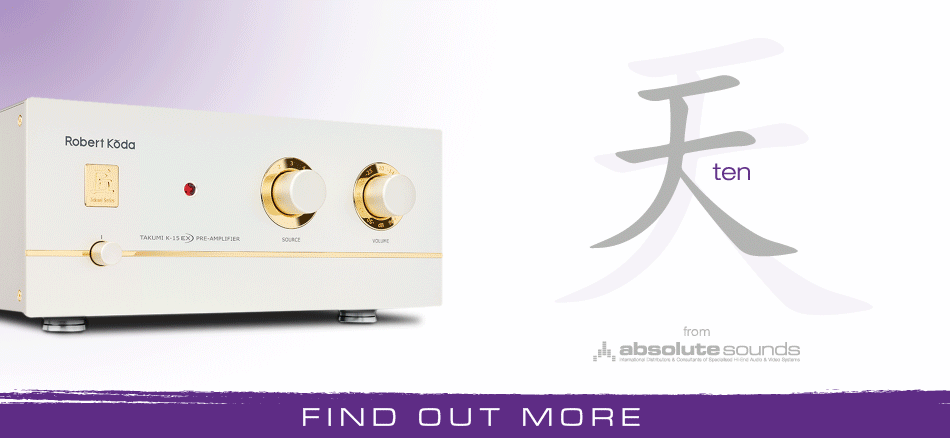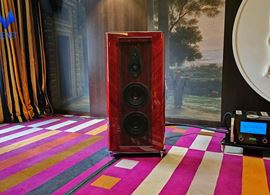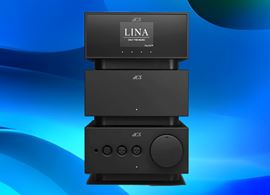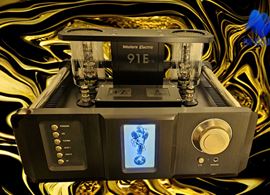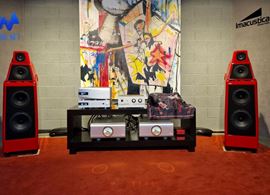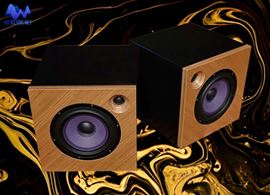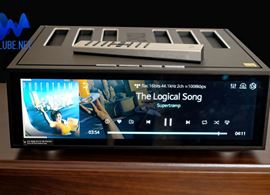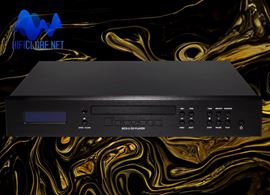I have been living with a pair of Franco Serblin Accordo Goldberg speakers for two weeks now, and I just can't stop listening to them. It has become an obsession for me.
According to Massimiliano Favella, Franco's son-in-law, who inherited his sketches and vowed to continue his work, Franco also became obsessed with Bach's Goldberg Variations towards the end of his life. He therefore decided to name this similarly shaped, but larger-scale version of the original Accordo after Goldberg. There is also a floor-standing version called Accordo Essence, but I find the 2-way monitor more in keeping with Serblin's original spirit.

The original (and smaller sized) Franco Serblin Accordo
Internal crossover
Like its predecessor, the Goldberg is required to be stand-mounted. However, the crossover is no longer fixed inside the stands; instead, it’s integrated into the speaker itself, as it should. This design allows for a larger choice of stands. However, the dedicated stands, designed specifically for the Goldberg, simplify the installation process, as the speaker must be fixed with screws to assure stability, being such a narrow design.
The Goldberg offers a symmetrical design with sensual undulating shapes and angles. These contours create a natural “toe-in,” directing the front panel towards the listener—an intentional choice for optimal sound dispersion. The speakers are subtly concealed behind a diaphanous veil of violin strings, reminiscent of the famed Guarneri speakers. While removing the veil enhances sound quality, it also sacrifices visual allure. Personally, I choose to keep the strings on, appreciating the aesthetic harmony it adds.

Accordo Goldberg, the perfect triangle
Svelte waist-line
The Goldberg features a larger mid-bass driver with a 180mm cone (compared to the Accordo’s 150mm cone). This contributes to a wider appearance seen from the front than it actually is with its svelte waistline when seen from above.
The rear reflex port is thoughtfully angled to minimise reflections on the front wall. To optimise performance, avoid placing the speakers too close to the wall or on a shelf; they need some space to breathe.
Beyond the audiophile norm
As I settle down to compose my review, I find myself grappling with the challenge of describing the Accordo Goldberg in a way that transcends the usual audiophile lexicon. You see, this isn’t just another pricey pair of 2-way monitors—it’s also an experience that defies convention.
Normally, I would start with the technical specs:
The Accordo Goldberg features a 29mm silk-dome tweeter meticulously crafted by Ragnar Lian. Paired with it is a 180mm woofer featuring a microsphere cone and an aluminium dust cap. These components are mounted on a super-rigid, arch-shaped solid wood gorgeous cabinet, thoughtfully decoupled with aluminium-magnesium parts to minimise resonance. But there’s more:
- Frequency Response: A wide range from 39kHz down to 23 Hz ensures nothing escapes its scrutiny.
- Nominal Impedance: A respectable 7 ohms, dipping to a mere 3.8 ohms at 5,500Hz.
- Sensitivity: A commendable 87dB—it won’t shy away from revealing nuances.
And then there are the dimensions: 40.5cm in height, 24cm in width, and 43cm in depth—a subtle enlargement compared to the original Accordo. These speakers weigh 25kg per pair, and their ideal perch is the factory 74cm aluminium stands with chrome bases. Price is €9,900 + €3000 for the stands.
Of course, you could read all these details in a glossy brochure instead, but still, that wouldn’t capture the essence of the Accordo Goldberg. So, let’s delve deeper now with a more subjective approach.

While removing the veil enhances sound quality, it also sacrifices visual allure.
Beyond the brochure
The refined and transparent reproduction of the Accordo Goldberg unveils every musical detail—the delicate rustle of strings, the breath of a vocalist, the resonance of a piano. The silk tweeter gives voices an ethereal quality, while the exceptional clarity of the midrange allows both voices and instruments to breathe freely, presenting the timbre and resonance of their true nature without compromising the musical and emotional depth that Serblin strived for throughout his life. Thanks to Massimiliano Favella, this legacy continues in the afterlife through his designs.

Yours truly (right) with Massimiliano Favella (left). Highend 2023, Munich.
The stereo image is holographic, yet precise, stable, and phase coherent. The bass is articulate and in tune with the rest of the spectrum, adapting well to all musical genres, from jazz to classical to rock, with enough extension to reproduce even modern electronic music.
Note: Stereo imaging has always been a significant concern for Franco Serblin. I recall discussing the Proscenium with him during the process of my Ktêma review. When I dared to mention that removing the Ktêma’s curved back panel resulted in better-articulated and more agile bass, he gently countered: ‘Perhaps so, but you are tampering with the Proscenium effect.’ And, as always, he was right. And I put the panel back.
Audiophile jargon
But here’s the twist: mere audiophile jargon isn't enough to describe what sets the Goldberg apart. These accolades could apply to many other high-quality monitors. Granted, they may not have the sensual appeal of the Accordo Goldberg, which makes me wonder if the exquisite shape follows the Fibonacci sequence. The Goldberg certainly seems divinely inspired because it sounds like a musical instrument tuned in heaven.
Franco possessed the vision of an ascetic, the humility of a saint, and the wisdom of a sage.

Had divine summons not intervened, this is how Franco would have unveiled the Accordo Goldberg. Rest in peace, my friend. (composite photo by JVH)
The Legacy Of Franco Serblin
What makes the Accordo Goldberg so uniquely captivating, then? Perhaps it’s the intangible—the way it resonates with your soul. And this is the essence that defines Franco Serblin’s remarkable legacy.
In 1996, I wrote in an article about Franco Serblin that he possessed the vision of an ascetic, the humility of a saint, and the wisdom of a sage, having acquired his vast humanistic, artistic, and musical culture directly from the pure source of Latin civilisation. Franco was a dentist before becoming an artisan of sound. And because he studied the physiology of pain, it paradoxically helped him to also master the art of musical pleasure. His work is therefore a reflection of his life.
When I listen to the Accordo Goldberg, I not only sense Franco's presence, but also the influence of other 2-way loudspeakers he has created. These include the Minueto, known for being light, bright, and lively; the Minima, characterised by its capricious, upright, and discreet nature; the Minima Amator, with its airy, fluid, yet sweet sound; the Electa, known for its generous and warm sound; the Electa Amator, recognised for its spirited, eloquent, and rich tone; the Extrema, known for its dynamic, fast, muscular, authoritative, and talented sound (I miss you, baby!); even the cute original Concertino, of which I proudly own a pair; and finally the Guarneri, which represents the ultimate expression of Franco Serblin's artistic balance and the measure of all things that came afterwards.

The Accordo Goldberg in Vicenza, their home town (composite photo) by JVH.
A gateway to musical art
The Accordo Goldberg combines the genes of all these speakers, yet it offers the most exquisite musical expression of all the 2-way monitors developed by Franco Serblin. As such, it is another posthumous masterpiece that opens a new gateway to the appreciation of musical art.
The Accordo Goldberg opens a new gateway to the appreciation of musical art.
Enhanced auditory perception
Anyone who has undergone a surgical procedure under general anaesthesia, as I have all too often in recent times, may recall a weird phenomenon as the anaesthesia gradually dissipates. Your brain, still groggy, compensates for the lingering haze of blurred vision by bestowing upon you a temporary gift: heightened auditory perception.
Suddenly, all the sounds sharpen into focus—the voices, the distant murmur of nurses, the ambient noise—all rendered with crystalline clarity. It’s as if our ears have been fine-tuned to hear every hint of acoustic reality around us.
As I was lying in the hospital bed, I thought the same happened with the Accordo Goldberg—my ears seemed more attuned to the subtleties unfolding on the soundstage, and I could hear every nuance and detail with incredible accuracy without the need for any drugs.

Franco Serblin Accordo Goldberg
Auditory pleasure
The Riviera Labs AIC-10, a hybrid headphone amplifier that also functions as a speaker amplifier at just 10W, powered them for the first few weeks of my listening at home. The immediate affinity between them may be due to their shared Italian heritage, but it also suggests that the Goldberg speakers are not particularly power-hungry. Fortunately, they have not inherited this evil gene from the Extrema, but rather one that enables them to produce loud sounds effortlessly.
Later, I heard them at Imacustica (where I captured the video below), with Jadis I300 amplification, which was a perfect match as both aim to captivate the listener.

Franco Serblin Accordo Goldberg at Imacustica: source dCS Bartok; amplification: Jadis I300
The Goldberg rocks!
There’s a misconception that all of Franco Serblin’s speakers are exclusively designed for listening to baroque music, as they are built with ancient string instruments in mind. I decided to test their capabilities by listening to electronic music first, as I was curious to discover how far—or rather, how deep—the Goldbergs would take me.
“Differently” showcases Marian Hill's style, blending electronic and vocal elements. The song combines electronic drum beats and percussion, creating a rhythmic foundation for the song. Synthesisers play an important role in shaping the overall sound, creating melodic hooks, atmospheric textures, and sound effects with sharp percussive elements. The Goldbergs didn't miss a beat.

Franco Serblin Accordo, dCS Bartok, Jadis I300
Then I cranked up “My Kinda Woman” by Mr. Big to live levels. Eric Martin's voice resonated with power and soul, carrying all the weight of raw emotion. Billy Sheehan's lightning-fast bass lines served as an anchor for Paul Gilbert's melodic riffs, and Pat Torpey's rhythmic accuracy provided the band with the gut-wrenching heartbeat that drove them forward.
Mary Stallings, Live at the Village Vanguard, is one of my favourite live jazz albums. It is the kind of "you are there" experience. Before each song, you can almost hear the hush of pure joy and anticipation as she steps up to the microphone and receives a round of applause from the crowd at her feet. Her range spans from a whisper to spellbound soaring power; her exceptional phrasing sculpts each song as a tangible work of art, and the audience shows their appreciation with clapping and loud nods of encouragement.
On stage, her soulful demeanour is complemented by Ron Blake’s tenor saxophone, which strikes the perfect balance of reed and horn. Eric Reed’s nimble piano playing adds vibrant hues to the canvas she paints with undeniable emotion. Vincente Archer’s bass and Carl Allen’s drums form the foundational heartbeat of the performance. From “Sunday Kind of Love” to “You Are Sensational” and “The Thrill Is Gone,” she takes both the audience and us on a musical journey of subtle introspection. Her voice becomes a beautiful instrument, skilfully accompanied by the band to perfection. Yes, Mary, you are truly sensational. So is the Accordo Goldberg.

Accordo Goldberg, a matter of style
Let’s play the piano now, shall we? “The Goldberg Variations”, by Glenn Gould, who else? An opening Aria followed by 30 intricate and hypnotic variations exploring harmonies, rhythms, and textures showcase Bach’s genius and help me type with even more intent while I listen. No wonder Franco loved the "Variations". These are soothing yet cheerful compositions that undoubtedly helped him during his last days.
Then, I drifted from Gould’s meticulous precision to the improvisational genius of another humming pianist: Keith Jarrett. The truth is that in “The Köln Concert” he engages more in an intentional rhythmic moaning than in Gould’s seemingly unconscious humming. The Accordo Goldberg followed along, changing tone and mood as required, delivering the beauty of both pianists' opposing styles to perfection.
Could the Goldbergs hold their own against Grieg’s “Peer Gynt”—its incidental music, complete with full orchestral and choral outbursts, entwined with Ibsen’s verse drama? The answer is a resounding yes. The balance was so exquisite that I scarcely missed the bottom octave that only significantly larger speaker systems can reproduce.
Massimiliano honours the legacy of Franco Serblin. You may rest in peace, dear friend.
Accordo Goldberg live at Imacustica
Note: Sound recorded live in-room
For further information, please contact IMACUSTICA, or your local dealer.

